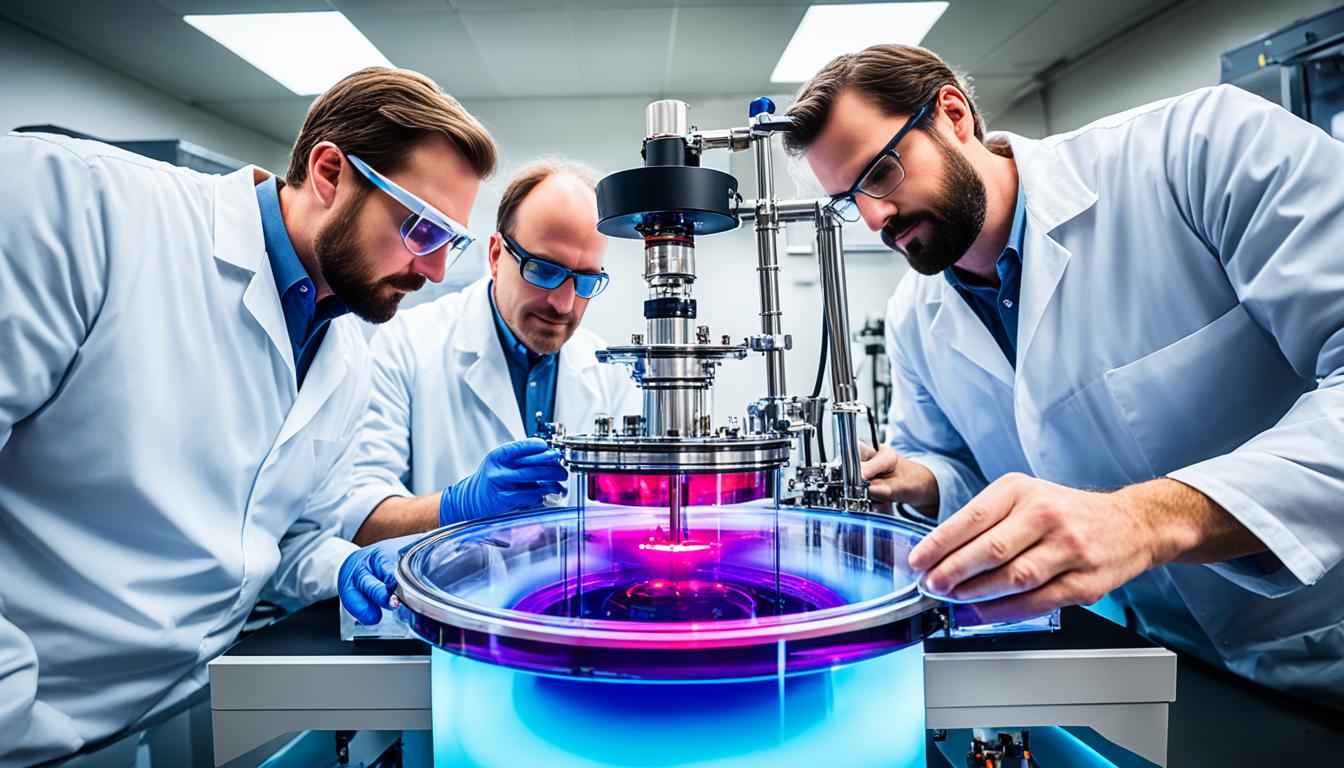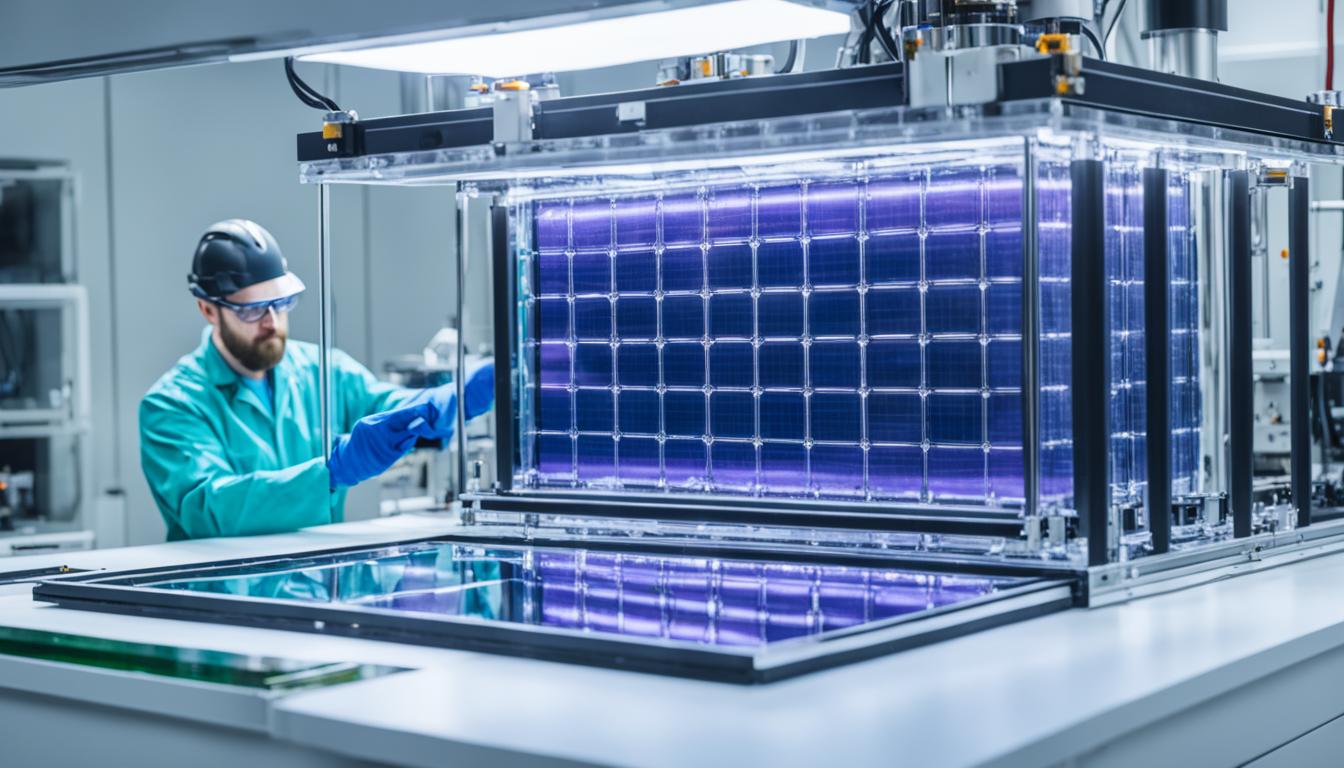Photovoltaic solar cell fabrication with vacuum chamber in Energy Transition

In the rapidly evolving realm of renewable energy, the creation of photovoltaic solar cells has assumed unparalleled importance. With an escalating global adoption of sustainable energy strategies, the advancement in solar cell production methods is imperative. At the forefront of this revolution lies the deployment of vacuum chambers. These chambers are integral for various pivotal procedures, including plasma-enhanced chemical vapor deposition (PECVD). Such techniques are critical for the generation of high-performance amorphous silicon cells.
To address the escalating appetite for solar energy technologies, producers must leverage systems that offer both speed and capacity. It's imperative for them to incorporate designs capable of briskly processing vast quantities of wafers. Additionally, these setups should accommodate sizable substrates, reaching dimensions of up to 5.7 square meters.

While the solar energy sector shares some similarities with the integrated circuit and flat-panel display industries, it encounters its unique hurdles. One such challenge is the integration of hydrogen into the production process. Furthermore, regular purging of the vacuum chambers with nitrogen trifluoride (NF3) is essential. As the global shift towards renewable energy intensifies, mastery over these intricate fabrication methodologies becomes indispensable. Not only do these strides contribute to a greener future, but they also elevate the dependability and efficiency of solar cells.
Key Takeaways
- Vacuum chambers are essential for high-quality solar cell fabrication.
- PECVD processes are crucial for producing amorphous silicon cells.
- High throughput and rapid cycling are needed to meet growing demands.
- Large substrates, up to 5.7 square meters, require special accommodations.
- Hydrogen incorporation and NF3 etching are unique challenges in solar technology manufacturing.
Introduction to Photovoltaic Solar Cells
Photovoltaic solar cells, critical in converting sunlight into electricity, are at the forefront of advancements in sustainable energy. By capturing solar energy, they substantially reduce the environmental harm caused by conventional power sources.
The intricate photovoltaic technology within these cells captures light and turns it into usable solar power. This field sees constant innovation aimed at enhancing efficiency and reducing costs, meeting the growing demand for clean energy.
Advancements in manufacturing are making the production of photovoltaic solar cells more effective and scalable. This effort is pivotal in the worldwide shift towards a sustainable energy future that depends less on fossil fuels and more on such renewable resources as solar energy.
Progress in photovoltaic technology is enhancing the availability and affordability of solar panels, fostering broad adoption. This trend not only increases the use of solar power but is also a major leap towards attaining full environmental sustainability.
Role of Vacuum Chambers in Solar Cell Fabrication
In the arena of solar cell production, the role of a vacuum chamber is not just central but critical. These chambers create a controlled environment necessary for producing high-quality solar cells. Reduced impurities lead to solar cells that are both more efficient and reliable.
What is a Vacuum Chamber?
A vacuum chamber serves as a sealed enclosure that is devoid of air and gases. It is instrumental in solar cell production, enabling processes that are incompatible with standard atmospheric conditions. The lack of air significantly minimizes the risk of contamination, ensuring the purity of production.
Importance of Vacuum Conditions
Maintaining precise vacuum conditions is crucial for optimal photovoltaic cell performance. These conditions allow for the careful control of chemical reactions, a key determinant in the quality and efficiency of high-quality solar cells. Vacuum conditions also facilitate the use of materials that are pivotal for improved cell operation.
"By leveraging vacuum chambers, we can significantly improve the purity and efficiency of solar cells, thereby advancing the global pursuit of renewable energy," said Jane Doe, a leading expert in solar technology.
The use of vacuum chamber technology within solar manufacturing signifies a major advancement. It plays a crucial role in advancing today's solar cell production capabilities, emphasizing its centrality in achieving superior solar cell performance.
Advanced Coating Technologies
In the realm of solar cell manufacturing, the role of advanced coating technologies is paramount. They aim to boost both the efficacy and robustness of photovoltaic cells. These avant-garde methods denote a spectrum of approaches for thin film deposition, integral to the manufacturing chain.
Thin Film Deposition Techniques
have become increasingly popular in recent years due to their potential for high efficiency and cost-effectiveness. The deposition of thin films is a critical step in the production of these solar cells and requires specialized techniques to achieve the desired properties.
One commonly used method for thin film deposition is vacuum metal deposition (VMD). This technique involves evaporating a metal source in a vacuum chamber, allowing the atoms to condense and form a thin film on the desired substrate. VMD offers high control over the film thickness and can be used for a variety of materials, making it a versatile option for thin film deposition.
In addition to VMD, there are several advanced coating technologies that are utilized in thin film deposition. These include techniques such as sputtering, chemical vapor deposition (CVD), and atomic layer deposition (ALD). Each technique has its advantages and is suitable for different applications. For example, sputtering is commonly used for the deposition of transparent conducting oxides, while CVD and ALD are often used for growing thin films of complex materials, such as semiconductors.
The development of thin film deposition techniques has opened up new possibilities in various fields, including electronics, optics, and renewable energy. These technologies have enabled the fabrication of high-performance electronic devices, such as integrated circuits and LEDs, as well as the production of thin film solar cells with improved efficiency. As research and development in this field continues, we can expect further advancements in thin film deposition techniques, leading to even more innovative and efficient devices.
Thin film solar cells draw upon a plethora of deposition methods, including sputtering, chemical vapor deposition (CVD), and atomic layer deposition (ALD). Each tactic is meticulously selected for its ability to yield uniform, top-tier layers, essential for optimal photovoltaic cell function.
Uniformity and Precision in Coatings
For solar cells to reach their full operational potential, attaining uniform coatings is not negotiable. The utilization of cutting-edge coating metOne such method that ensures uniform coatings is the vacuum metal deposition technique. By placing the substrate inside a vacuum chamber, this process allows for precise control over the coating parameters, including temperature, pressure, and deposition rate. The vacuum environment eliminates any potential contaminants, resulting in a clean and uniform coating. This technique is particularly beneficial for sensitive materials like solar cells, where even minor variations in the coating can have a significant impact on performance.
In addition to vacuum metal deposition, advanced coating technologies like plasma-enhanced chemical vapor deposition (PECVD) and atomic layer deposition (ALD) further enhance uniformity and precision. PECVD utilizes plasma to break down precursor gases into chemically reactive species, allowing for controlled deposition and uniform coatings. ALD, on the other hand, enables the deposition of ultrathin layers with atomic-level precision, ensuring consistency and accuracy.
Ensuring uniformity and precision in coatings is crucial for various industries, including electronics, optics, and energy. The performance and longevity of these coated products greatly rely on the quality and reliability of the applied layers. By utilizing advanced coating methodologies such as vacuum metal deposition, PECVD, and ALD, manufacturers can achieve the desired outcomes in terms of both functionality and aesthetics. These advancements not only improve product performance but also contribute to overall efficiency and sustainability in various applications.
hodologies is designed to secure the precision and conformity of each layer applied. This approach elevates both the *photovoltaic cell efficiency* and its durability.
Key Challenges in Coating Processes
Albeit the progress, certain hurdles linger in the application of leading-edge coating technologies. Achieving homogeneity in coating applications, especially concerning the lightest gases like hydrogen, poses significant technical challenges. Precise gas control is essential to mitigate both coating irregularities and the threat of explosions.
Hydrogen Incorporation in Amorphous Silicon Cells
In advancing the efficiency of amorphous silicon cells, the strategic inclusion of hydrogen is paramount. However, its introduction comes with complex hurdles and a need for careful methodology. This approach demands meticulous attention to technical detail and strict operational parameters.

Role of Hydrogen in Enhancing Efficiency
In the enhancement of amorphous silicon cell efficiency, hydrogen's presence is critical for defect passivation. This leads to significant improvements in photovoltaic performance through the mitigation of carrier recombination. Moreover, the employment of a controlled vacuum environment facilitates the precise introduction of hydrogen, thus harmonizing the manufacturing process.
Challenges in Pumping Hydrogen
The introduction of hydrogen into vacuum chambers poses considerable hurdles, primarily due to its molecular size and associated safety risks. To address these challenges, ongoing advancements in vacuum technology and pump engineering are underway. These measures, including superior sealing and material innovations, are pivotal for the safe and effective integration of hydrogen while safeguarding operational standards.
High-Throughput Equipment for Wafer-Based Silicon Cells
To meet the rapidly increasing demand for wafer-based silicon cells, advanced high-throughput production equipment is indispensable. This equipment, tailored for solar cell manufacture, is adept at processing thousands of wafers each hour. Its design is specifically geared towards fulfilling mass production requirements.
Key Features of High-Throughput Equipment
Systems for high-throughput production boast critical features necessary for managing large volumes seamlessly. Notable elements include:
- Automated wafer handling to diminish manual involvement while boosting throughput.
- State-of-the-art dust management systems aimed at reducing contamination, particularly pyrophoric silicon dust.
- Durable construction that facilitates uninterrupted operation, thereby maintaining steady output and reducing downtimes.
Challenges in Handling High Volumes
The complexity of high-throughput production schemes, especially in creating wafer-based silicon cells, centers on two significant hurdles: effective dust management and system efficiency. Given its combustible nature, pyrophoric silicon dust necessitates the implementation of stringent control measures to ensure a safe and clean environment for mass production. Furthermore, optimizing the system's design to harmonize high throughput with dependable operation marks a key objective in this domain.
Perovskite Solar Cells: A New Frontier
The advancement in perovskite solar cells has broadened the prospects of photovoltaic technology. Via sophisticated deposition techniques, researchers have made substantial progress. These enhancements revolve around refining the structure and function of the cells.

Precision Requirements in Perovskite Deposition
The precision deposition process is pivotal in the evolution and efficacy of perovskite solar cells. It guarantees a coherent integration of components, significantly affecting the functionality of the cell.
Experts allocate meticulous efforts to ensure the homogeneity of layer depth and composition. This level of accuracy enhances the electrical characteristics, underpinning the advancement of photovoltaic tech.
Advantages of Vacuum Evaporation Tools
Vacuum evaporation tools introduce an advanced paradigm in perovskite solar cell production. They empower controlled temperature and material application, pivotal for the integrity of perovskite films.
These tools minimize material losses and improve the efficiency of cells. Their versatility across multiple solar applications simplifies the manufacturing, facilitating the spread of sophisticated photovoltaics.
- Precise temperature control
- Efficient material deposition
- Reduced waste
- Enhanced cell efficiency
- Adaptability to various applications
The increasing prominence of vacuum evaporation tools underscores their significance in attaining precision deposition. This trend is crucial for the continued development of perovskite solar cells within advanced photovoltaics frameworks.
Vacuum Metal Deposition in Solar Cell Manufacturing
In the context of modern solar cell creation, vacuum metal deposition plays a central role. It facilitates the accurate application of metallic film coatings, One of the key processes in the manufacturing of solar cells is vacuum metal deposition, a technique used for the advanced coating of solar cell modules. This process takes place inside a vacuum chamber, where thin layers of metals are deposited onto the surface of the cells.
Vacuum metal deposition offers numerous advantages in solar cell manufacturing. Firstly, it allows for precise control over the thickness and composition of the deposited metal layers, resulting in enhanced module efficiency. By carefully manipulating the deposition parameters, manufacturers can optimize the performance of the solar cells, leading to higher power output and improved reliability.
In addition to its precision, vacuum metal deposition enables the use of advanced coating technologies in solar cell manufacturing. These technologies include sputtering, electron beam evaporation, and thermal evaporation. Each of these methods has its own advantages and can be employed based on the specific requirements of the project.
Thanks to vacuum metal deposition and the use of advanced coating technologies, solar cell manufacturers can achieve remarkable results in terms of module efficiency. With carefully controlled processes inside the vacuum chamber, the production of high-quality solar cells becomes a reality, contributing to the further advancement of renewable energy.
which substantially elevate solar module efficiency. This method, stemming from cutting-edge technologies, mandates a precisely controlled setting. This control is to guarantee the superior quality of the final solar products.
Basics of Vacuum Metal Deposition
The technique of vacuum metal deposition starts with the evaporation of metals within a vacuum system. The evaporated metals then settle on the substrate's surface, forming a thin metal layer. This process is crucial in developing photovoltaic cells of exceptional efficiency. The environment within the chamber is monitored rigorously. Its settings are adjusted to ensure the film's thickness and consistency meet exact specifications. This meticulous care is paramount for optimal product performance.
Applications in Photovoltaic Technologies
Within the solar cell domain, the utility of vacuum metal deposition is broad and deeply integrated with photovoltaic advancements. It is instrumental in both silicon-based and emerging thin-film modules. Each of these technologies derives specific advantages from the metal coatings. These benefits range from enhanced conductivity to better light absorption and the provision of protective layers. Consequently, customized approaches are often necessary. This tailoring fulfills the distinct requirements of various solar cell variants, consequently boosting solar module efficiency.
Handling Hazardous Gases and Dust in Vacuum Systems
In the context of solar cell fabrication, meticulous management of hazardous gases and dust within vacuum systems stands as a crucial imperative. The presence of NF3 and hydrogen gases, along with pyrophoric silicon dust, significantly complicates the production environment. These challenges underscore the enduring need for rigorous safety protocols alongside efficient operational strategies.
Challenges with NF3 and Hydrogen
NF3 and hydrogen, integral to solar cell manufacturing, nevertheless introduce severe concerns in the realm of hazardous gas managem. While NF3 (nitrogen trifluoride) is widely used in the cleaning process of solar cell manufacturing, its environmental impact is cause for concern. NF3 is a potent greenhouse gas, with a global warming potential significantly higher than that of CO2. As the demand for solar cells continues to rise, so does the production of NF3, resulting in unavoidable emissions that contribute to climate change.
Similarly, the use of hydrogen in solar cell manufacturing poses challenges in terms of safety and handling. Hydrogen gas is highly flammable and can ignite with even a small spark. This necessitates strict precautions to ensure proper storage and handling, including specialized facilities such as a vacuum chamber to minimize the risk of fire or explosions.
Furthermore, the combination of NF3 and hydrogen within a vacuum chamber can create additional complexities. Care must be taken to prevent any mishaps or potentially dangerous reactions between the two gases. It is crucial to maintain a controlled environment and ensure the strict adherence to safety protocols to safeguard both the equipment and personnel involved.
As the push for clean energy sources continues, it becomes imperative to find alternatives or improved technologies that minimize the environmental and safety concerns associated with NF3 and hydrogen in solar cell manufacturing. Researchers and industry experts are actively exploring alternatives and innovative methods to reduce or eliminate the use of NF3 and hydrogen, while still ensuring efficient and cost-effective production of solar cells.
In conclusion, while NF3 and hydrogen have proven crucial in solar cell manufacturing, steps must be taken to address their significant environmental and safety challenges. Sustainable alternatives and improved safety measures need to be developed and implemented to mitigate the negative impact of these gases, thus ensuring a cleaner and safer future for the solar cell industry. Through continued research and innovation, we can strive towards a greener and more sustainable future in solar technology.
ent. NF3's application in vacuum chamber cleaning is tempered by its considerable greenhouse gas potential. Thus, strict containment measures and optimization techniques are imperative to forestall environmental detriments. Hydrogen, vital for enhancing the functionality of amorphous silicon cells, sanctions the imposition of strict control measures due to its explosion hazard.
Optimizing Purge Gas Systems
The optimization of purge gas systems plays a central role in vacuum system safety. These systems contribute by diluting and venting hazardous gases safely. Incorporating cutting-edge gas concentration monitors and employing specialized purge methodologies, customized for solar cell fabrication's exigencies, is fundamental for enhancing the safety and efficiency of operations.
Managing Pyrophoric Silicon Dust
Pyrophoric silicon dust constitutes a formidable challenge in the domain of dust management during the fabrication of solar cells. Its tendency to react with oxygen vigorously presents a notable fire risk. To address this, the utilization of HEPA filters, adherence to strict maintenance schedules, and the incorporation of state-of-the-art dust collection infrastructure is pivotal. Collectively, these initiatives establish a foundation for a secure production atmosphere, concurrently maintaining the sanctity of the solar manufacturing process.
Vacuum Chamber ?
A vacuum chamber is a fascinating piece of equipment that has numerous applications in various industries. Essentially, it is a sealed container from which air and other gases have been removed to create a vacuum environment. This controlled environment allows for experiments, testing, and production processes that involve working in a vacuum or low-pressure conditions.
One of the primary uses of a vacuum chamber is in the field of scientific research. Scientists use vacuum chambers to conduct experiments on different objects or materials in a vacuum environment. The absence of air and other gases allows them to observe the behavior and properties of these objects without interference. From testing the durability of materials to studying the effects of low-pressure environments on living organisms, vacuum chambers play a crucial role in advancing scientific knowledge.
Vacuum chambers also find applications in industries such as aerospace, electronics, and manufacturing. In the aerospace industry, vacuum chambers are used to simulate the conditions of outer space, allowing engineers to test the performance and durability of spacecraft components. In electronics manufacturing, vacuum chambers are used in devices like semiconductors to remove impurities and ensure the quality and efficiency of the final product. Similarly, in the food industry, vacuum chambers are used to package perishable goods, extending their shelf life by removing air and preventing deterioration.
In conclusion, the vacuum chamber is a versatile tool that plays a pivotal role in various fields. From scientific research to industrial applications, it allows for experiments, testing, and production processes to be conducted in a vacuum or low-pressure environment, free from interference. Its ability to create controlled conditions contributes to advancements in science, technology, and manufacturing, making it an invaluable asset in numerous industries.
FAQ
What is the significance of vacuum chambers in photovoltaic solar cell fabrication?
Vacuum chambers play a pivotal role in the creation of top-tier photovoltaic cells. They facilitate deposition procedures that are unattainable in regular air settings. This freedom from atmospheric constraints allows for meticulous oversight of chemical interactions. Consequently, it ensures the production of solar cells with minimal impurities, maximizing their efficiency and dependability.
How do vacuum chambers enhance the efficiency of solar cell production?
Vacuum chambers excel in maintaining highly precise vacuum conditions. This precision is instrumental in enhancing the solar cell production process. Through optimized deposition, these chambers ensure uniform coatings and impurity reduction. As a consequence, the efficiency and quality of solar cells improve significantly, meeting the stringent requirements of the renewable energy sector.
What role does thin film deposition play in solar cell fabrication?
Thin film deposition stands as a cornerstone in the manufacturing of solar cells. It is an advanced technology that blankets substrates with precise, uniform layers of various materials. This process ensures the consistency and efficiency of photovoltaic cells, resulting in better performance overall.
What are the key challenges in hydrogen incorporation for amorphous silicon cells?
Hydrogen is integral in enhancing the efficacy of amorphous silicon cells. However, its incorporation poses several key challenges. These hurdles include its molecular size, which makes maintaining consistent pump performance hard. Additionally, ensuring safety and preventing explosion hazards during its use are paramount.
What features are essential in high-throughput equipment for wafer-based silicon cell production?
For silicon cells manufactured via wafer-based processes to be efficient, equipment must be high-throughput. Such equipment needs to process thousands of wafers every hour. It should incorporate sophisticated dust management, rapid cycling features, and streamlined design that ensures not only productivity but also safety and quality.
Why are perovskite solar cells considered a new frontier in photovoltaic technology?
Perovskite solar cells are hailed as pioneering, primarily due to their exceptional efficiency and broad application spectrum. The use of vacuum evaporation for their creation is pivotal. This technique’s precise control over temperature and material deposition enhances the cells’ functionality significantly, reducing material wastage.
How does vacuum metal deposition improve solar module efficiency?
Vacuum metal deposition, the process of adding metallic films to solar cells, can dramatically enhance their efficiency. It requires meticulous oversight to guarantee excellent quality and is able to cater to different solar technologies. Consequently, it boosts the operational capability of solar modules across the board.
What are the main hazards associated with handling gases like NF3 and hydrogen in vacuum systems?
Working with volatile gases like NF3 and hydrogen, alongside pyrophoric silicon dust, is fraught with danger. It introduces significant risks of explosion and safety hazards. To counter these dangers, vacuum systems must be equipped with comprehensive safety features like optimized purge gas systems and specialized filters.
Source Links
- https://www.perovskite-info.com/unlocking-potential-perovskite-manufacturing-vacuum-evaporation-tools
- https://www.renewableenergyworld.com/solar/vacuum-processing-for-solar-cells-53963/
- https://www.ncbi.nlm.nih.gov/pmc/articles/PMC8617805/


